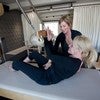Description
About This Video
Transcript
Read Full Transcript
My name is Diane Severino and I was born in Brooklyn, New York, in Coney island by the sea sea. The sea behind you look nothing like that. And my upbringing and my dance training was in Brooklyn in the early days and through the dance world is how I got introduced to Ron Fletcher. Introduced not the right word. I got to Los Angeles. I married out here and was looking to expand my dance classes.
I was always a dance teacher and I knew Ron's named from the dance world, from Icecapades and from a few Broadway shows. And I had a girl that was taking my class and knew I wanted to expand and said, there's a dance studio upstairs from where I get my hair done. It was a beauty pollical that you'd agree. So a day I took myself to Beverly hills on Rodeo and Wilshere walked up, had my attest shake case with my resume in it and walked in and went, oh my God, it's a plotty studio. I've never had any introduction to polite, even though I knew about it from the dance world. But what I knew about it was that it was injured dancers and I never had an injury. Unbelievable. But I didn't have great dance training as a child.
I think that attributed to it. And, uh, uh, went up and Ron was there and introduced myself to him and I took out my resume and it was like a meeting of souls. Seriously, that sounds really like the airy fairy, but it's not because my resume was the background that he had. We had very close connection with our teachers, the Graham Co connection and just on and on and on. He was astounded. So that right there for him reading who might my, my teachers were, was very important. And we gabbed and talked and gossiped about the dance world. And, uh, he said, well, obviously it's supplied his studio, but, uh, so nice to meet you and maybe we'll do lunch. Great. I go home to the San Fernando Valley, which is where I still live in Los Angeles.
And about an hour later the phone rang and it was Ron, Ron. Hi. It wasn't that fun. I'm so happy to meet you. And he said, I don't know what I was thinking. Would you like to teach this work? I want. Okay. So I made an appointment with him the next day and four days later I was on staff. Now that's very unusual now with the training thing. So it's, yeah, it was the way it was done back then when you really just apprenticed and picked up, you know, now I'm an easy study cause I was a dance teacher since I was 14 and a lot of the correct alignment, they'll pull out, he says unto itself, it matched the way I was correctly taught as a kid. So I sort of got it also at the studio on the ceiling were all of the exercises.
So even though I jumped in and I had a, not Ron taught me, but the buddy who was one of his teachers there four days of classes and then they cut me loose. And if I ever had to remember an exercise they would just say, and then we do heels next. So I was able to teach from that day on. Now, there was a rite of passage that they did when you were a new teacher. They gave you all the beginners. Hell, okay. Hell one after the other.
I'm telling you in a week of beginners, an eight hour day, you knew how to teach the [inaudible] work and a, so that was my entree. That was 1973 good law and the numbers are getting big as 1973 and uh, just Ron was magnificent to work for. Really. He was of course a movement genius. He was the creative. But I think sometimes there's a misconception that Ron changed the polite, his work, not so on the wall of the studio was the classic machine workout pictures of Joe himself. You know, all the ones I'm talking about, the black and white ones with him and the trunks and the, Ron learned the work from Joe. He didn't deviate from it.
It was what we were teaching our students, which were the, who's who? Beverly Hills, the ladies that lunch, the society, ladies, the actors and actresses Kayvan droves to the studio. And then you're just regular. We're up pedestrians and everybody was treated the same at the studio. The high standards applied to everybody. Everybody was ready to go at the appointed hour, an hour session, an hour workout. It was all done individually.
But again, they were proactive because of that work on the ceiling. I'm almost pointing up to Ron to I, uncle Ron, I called him uncle Ron because yeah, I called him uncle Ron forever. So, uh, everybody had a focus and uh, we, we didn't coddle them. We really made sure that they did the work correctly and they were, you know, we would walk the room and make sure everybody's, you know, alignment and everything was correct and done well. They had their session on the machine and then there was always the mat work that went along with that.
So a lot of the rumors are that Ron deviated and change stuff. Not So, I mean, everybody knew I still to this day can go through the [inaudible] mat work beautifully. It's brilliant. Hard as hell, but, and had to work. We didn't give them a, the whole thing was we had an hour session. So there was about 12 exercises that they had to do in conjunction with the machine knee. Early days there wasn't a studio space for the classwork.
So that's where I think people misunderstand what Ron did. But in the beginning of the, of the studio days, there was no space. It was only machines, trap table, Petty Pole, big and little barrels. Everybody went through all of the equipment, the way Ron had been taught from Joe. And we then translated that to our students and they had a very solid background in the correct way to work, which is why all of the entertainers came to us.
Because when you do the plays, Ron Fletcher work correctly, it sticks to your bones. You can go out on location and come back after a three month shoot, your strength will be gone. But the local hold itself, so it was very popular with the entertainment crowd. I mean we had more movie stars than like the back lot of universal. Everybody came. I, there's a laundry list I can buy a with everybody that came to us, you know, talk about having to, you know, keep your ego in check and your imagine looking at all those Hollywood beauties at like seven 30 in the morning. And the sun was like hitting him perfectly, like a key light. You know, he had to be really secure in that studio, let me tell Ya. But everybody was really great. I mean, everybody left their egos at the door. The studio was so supportive and they were supportive of Ron and all of his staff.
They treated me wonderfully and a lot of those movie stars became my friends and I slept over their houses, you know. And uh, it was just wonderful, wonderful place to work at the studio. The other teachers that work with me was run, uh, nephew, uh, Richie. He was there, but he Sperber. Then I brought on my friend Michael Pod Wall, who we known from the dance world and Carol Monaco, now Michael Podwell and Carol Monaco. And I kept the studio going after Ron decided to dishpan the Wilshu studio and move on to teaching his seminars and to not have his nine to five job. Uh, those are the main teachers. I remember there was Ingrid and uh, but pretty much that was the main mainstay about group.
Everybody had their own talents. Richie was a big buff, you know, he was Ron's nephew actually, uh, John Battles that runs a partner in life. And uh, he was, didn't come from the dance world, but Ron trained and meticulously, he moved beautifully. But he had the draw because he was buffed and spoke well and the gals loved them, you know, so he had his drug buddy had more of a dance background in ballet and he was the son of a doctor who was very articulate and spoke at atomical words like deltoids and rum Boyds and you know, so I had an education with him because I didn't have any anatomy when I was in school. And then of course, Michael Pod wall coming from, again, the same background is run and I just ate the workup and just took three classes. And again was starting to teach. I mean, but we had the similarity because we know what Ron was talking about cause we had the same teachers and Carol Monaco came from Los Angeles, from the ballet world and uh, she came aboard and we all worked marvelously together so well together. Carol, Michael and I that, uh, we, uh, uh, begged, run if we can continue his name. This goes back to 19, about 80, 81 and essence the studio was disbanding on Rodale.
Uh, could we please keep the name going? Ron Fletcher studio for body control algae. There was no politeness in the name, but that was the old Monica that Joe had as sort of the subheading of what Paul Audis was, was the studio for body can draw ology. And so we kept that name Ron with Ron's permission. And we opened up our first studio near the Beverly Center on Third Street.
And, uh, we kept the studio going, uh, for over 20 years. Carol left and opens her own studio, which he still has now in the San Fernando Valley. And Michael and I worked together 20 years sharing the same checkbook and never had a fight. We were like, perfect, get it. We would like so perfect. So Carol sort of branch that and retains her studio and Michael and I, uh, kept the Ron Fletcher Studio Full Body Control g for 20 years. So we kept his name and legacy alive and, and Ron was never intrusive. I mean he trusted us with the work which we, you know, carried on. And uh, that's how we are now. Hm. Hm. Hm.
Now I remember when Ron started the class work and develop the tower work. It started when he broke through the wall where we just had the room with the machines and was able to utilize this glorious space that was just a storage room that the beauty parlor, it 80 gray hat. Once we broke through that room, we had space we could move. So Ron started classes. It was as simple as that. It was, the opportunity was that he had a place to lift his arm up and take it to a flaw class level. So then it transferred. Remember I said earlier that the students were doing the mat work because that just requires some small amount of space and just timing.
So they did their 45 minutes and then their their mat work, but now we can get a lot of people in during a, now it's slot and Ron could teach a group of people very successful and it was just fantastic. It was a real classroom situation. He approached it, you can almost say it was like a dance class of sorts, but it was not a modern dance class. It was Ron's work and as accumulation of his movements that his teachers, his past them a little bit of grand, but it was not a gram class and because Ron was a choreographic genius, he can vent a piece of movement in three minutes. I mean it was unbelievable and because we had the same students there so regularly, he could build upon a piece.
We could start out something if he was just trying to get the muscles to respond and then take it a step further on the next class. Then one of the reasons, the things that always drove him in all of us teachers crazy is that if anybody lists their arm and it just looks like a just stupid shoulder up. No, no, no, no lattes, no freedom in the shoulders, shoulder girdle. And Ron was getting so sick and tired of everybody not getting it that he said, okay everybody you got to your towel. Ronald was, we provided towels. Ryan actually just took the towels home every night and washed them. I mean we, yeah, we every homespun you know, we run Rodale and Wilshire, so everybody grabbed the towel and he literally just started, you know, pulling it apart with the breath. You know, Ron of course invented the Protestant breathing. That was his departure from, from the original plot. His work was, Joe just said, breathe in with the good out with the bed. So Ron just started with the towel, you know, and you know, and then you know, took it to another level and he just started improvising it and then a little bit higher, you know, and a little bit back and you know, and he started creating this whole class on this. At first it wasn't a hole, a towel class, it was just introduced within the class format.
But then he started again because his creativity was so large that he was able to get his own syllabus going and have an hour workout there where he turn to the backs and he did laterals and you know, and everybody was going, Oh, I love it. I, the plight is made my body better. But I like the way this feels in my arms and toning up in my chest is opened up, you know? And so it created this whole a syllabus class of, of the tower and it's a quite challenging and quite beautiful. So now we're on, this is the error. It's about in the 80s, maybe mid eighties. Then again, Michael and I now all the studio, Carol has her own studio in the valley.
And I've been teaching Ron's work. I was his assistant, I was his right hand man. I took his class every day at my lunch hour. I just loved his classes in the sense of moment. It was like, this is me, you know, I every day at lunch I was so skinny then anyway, so, uh, yeah, cause they would've gave up my lunch. Uh, so, um,
It's going to be bare bone shoot. You know, just you and me, you know, before I, I lose all of this, you know, and he said, what I think we can do that, you know, so we [inaudible] set up a time and uh, we went to UCLA, she had everything ready to grow. It was just like just said, just a bare studio. And literally because I was Ron Shadow movement wise, they just said,
And those of you that know the Fletcher Towel work, now you can see how it's evolved. He was always, always learning, always doing, always inputting. He got a lot of, uh, input from us movers around him. He did like it when Michael and I came to the studio. He could see things on our body that some, that they couldn't really see, not to put anybody else down. But Michael and I, again, we had that same background. So he was developing a lot more movements on our bodies and getting spurred on and getting excited about it. And it was very interesting. Yeah, that's the video or I was fortunate enough to be, uh, invited into Ron's world when he got the book. The account lifting cotton company was the publisher, very big company. And they did a lot, all these big hardback books and it was the first celebrity exercise book.
It's called everybody is beautiful. And uh, Ron asked me to come in. Barbara Wilson was the photographer. We're still best friends. I just had lunch for the last week. So Barbara was the photographer and my job was to direct the, the shoot, the exercises that Ron had determined were going to be in the book and no machine work was all his movement classes. And it was stage the beginning beginning, intermediate and advanced work. There was also a section on handicap people cause Ron did work with Elman.
She had not the use of her legs. So there was a series of there. They also was a section on the agent body and I'm close to the sage but it seems so, she seems so old. She was a 71 year old woman. I'm so close to that now. But it was amazing. So there was these sections in it. And so my part in the book was to make sure everybody looked perfectly ready to be shot at that moment. So I directed the shoe.
I also helped run in formulating the words that went with each of the a series of pictures that will lay it out and you can get in really good shape with that book. That book has a lot of information, goes into all of the percussive breathing and his philosophy and I dig it up, get it on Ebay. It should have gone into a second printing lipid caught and company went bankrupt. Now the tragedy in that is that it didn't go into a second printing. The other tragedy was that in the bankruptcy they lost the prints. They lost the template, whatever they do to reproduce the book.
W couldn't believe it. It was like, that's bad luck. I mean that's just bad luck, but it just like disappeared. There was no conspiracy, nothing. It's just that the company went belly up and Bam, you can't do another printing. A 1999 Michael and I had a close out Third Street studio, the 20 wonderful years when the building was being sold.
Now Elise was up who sort of this trifecta. Michael's father in Florida was getting elderly and he decided to make the move down there to help his dad. God love his heart. And uh, uh, I could not go on without Michael. He was so just the dynamic duo, the two of us. I mean, it was just no way I was going to go solo and I'm going hand over, you know why at that point, almost like 30 years of teaching the work. So we decided to end the Ron Fletcher Studio for body control. Ology Michael moved to Florida. I retained, I always had a private clientele, so I wasn't left high and dry. You know, though I did walk out with just a little shoe box, full stuff. It's like, I mean it was like in the movies, this is my life. This I gave my life to run and it's a shoe box, but a, so it was, it was poignant, but I was able to dress transition because of my private clientele and also float around.
I'm one without a studio for the first time I had a parking space in a shower, you know, so that was a little difficult to deal with in a way. Cause I had my pet a tear and you know, so now I had to like be at the mercy of all my friends that had, you know, [inaudible] studios to come and teach, you know, at their places, which I do and I still continue to this day. You know, I do float around and uh, and then I uh, most of my clients find the private, they're there another stratosphere so they have their own workout rooms. I had my own showers in these houses, you know, and they're very disciplined cause they just know that the work has worked for them so many years. Then some of my private students that had been with me like 30 years. Yeah, it's amazing. You know, the body doesn't know it's getting old if you do keep doing it in the right way. I mean they really still doing like four springs on leg and foot work to let you know, three on single.
But I mean it is interesting this the and a does give ones maturing body hope because my students of my role models too. I mean I learned all teachers know that when you teach you learn so much. And uh, so yeah, I'm very fortunate that I have a very low loyal following that's still at once to hear what I have to say every week, three times a week. I blessing and that's sick of me at, it's unbelievable. You know how I learned them at work?
Ron gave me his copy of a return to life. That's how you, cause this is all school. Even just get everything spoonfed yet, you know, you like, you want to learn it, you learn it, you know. Now me being Diane, having a Gig, great background and movement, I took a magnifying glass, I studied those pictures. Now I read the instructions and I really would shed it. They learned it on my own to really get the finer points. We had begun the 12 mat exercises that our students knew. Single leg, double leg. Yeah. Yes, I, you know, psychics, et cetera.
But some of the other stuff that's in the book, I had to really take my time and learn it on my own body and so on the tangent from the are there, but I, uh, pretty much do the whole workout. Dominoes short spine is delicious. I love short spying. I love them all. Stomach massage, wanting underused exercises. Stomach massage is brilliant. Now we're on now. Ron was a tall guy, right? You try this when you're in impact, it's, the machines are a little bit different now, but it worked in our old Fletcher machines. So say you're laying on your back and in plotty stance we called it first position turn out because we came from the dance world. But polite stance, right? Like you're doing legged foot work. You come on, you're laying on your back. I could do it, but you're not pushing back. You, your legs are in play and then you start to roll up. You take your articulation, you roll all the way up and what happens?
You roll up your in the position to do stomach massage. You try that. You try that. Uh Huh. Let's see. If you don't get a cramp right up here, all right. Stomach, besides brilliance. Now everybody's clocked. You must be elegant and pull up, up, up. Yeah. Not schlump and down. People are still interested in the work. I think they're surprised that it takes such a commitment and it's a little instantaneous the way this world is now. The long haul seems to, you know, be a little offsetting to some.
So there's always going to be a drop out rate. Uh, but I see a little more in patients now and I think, uh, people are not as humble as they were when the work first came out and they, they think they're going to be better at it's quicker. Right. I don't know why, but they just are sort of surprised that they're not instantaneously getting the final points of it. And that seems to create a little bit of frustration. So there's the people that can, that stick and that, that don't, I think people are doing a lot of stuff now. They are doing so many things. I mean, it's, uh, and I don't even see the Biden's looking any better. I'm in this spinning, they're doing polite is they've taken a yoga class, they're doing TMX or whatever that hanging from the ceiling, you know, it's like Geez, I mean how much w w y, y, you know, that, that, that I see is different, you know, and but yoga and don't get me wrong and Yoga and pilates works beautifully together and a nice walk is lovely too.
But it just seems that people are really, really pound in their bodies, you know? And of course, yeah. I mean I don't know anybody my age that's still doing the work that would hold up as well. So I caution a little bit about the burning out effect and the wearing and tearing as a body. You take, you know, dances on the winter holidays cause they got hurt and talk about athletes. Dancers are supreme athletes but the body tears down. So I would caution everybody now to just think, think lovingly about your body and don't beat it up. You know?
I mean don't be a whack job though, right? When you're doing a machine and when you're doing the floor work, you are moving, you are moving, you are making beautiful patterns in space. I Ron and I agree with it. I don't like the word exercise. Movement is a better way cause you are moving and if you're a man or a woman, I mean can you make it look elegant?
Can you make it look like someone's going to want to watch you push back? That machine makes a difference on how you move. The body will react to the way the brain is thinking about it. It's not just schlepping back and forth and back and forth. Does it matter how one lifts the arm? Yeah, it matters.
[inaudible] who is going to look at that? How you lift the on? Where does it come from? A teacher has to tell you that it's not intuitive, you know, but there's a reason that that hands lifting there, you'll have to have intense in the movement. It shows in the body the elegance that it gets, the articulation and the more integrated potty parts. When the movement is beautiful, it takes a lot more effort. Not to forget your feet or your hands so their whole body works as a concert.
You're not just taking, you know like a car and taking your fender and getting fixed. It's the whole that works together. That's when your eye wants to see it and I don't care. My eight year old grandson can walk into a room and see birth and the one is going to look with is the one that looks good doing it for himself. Then his, I will go to that student, he will do, he will focus on that student, the triangle, the urgency, the urgency or the intense.
It's important to move correctly and to keep it growing. Always keep it growing. Always up. Always. It's too easy to do this. Curious saving has created a day with Diane through the run for Fletcher Program of study and what that is is you get me for the day a class and I go into a lot of the, so I call myself a prehistoric Fletcher, go into this. A lot of the movement history of how some of the, that the people that are in the program of study are doing it today.
But how it started, what was, what was the beginning of that movement like, and it's a full out class situation depending on the studio's time and the allotment that they give me and I take him through a, the Ron's work with, of course, my flavoring. No, like I said, you flavored with who you are too, but it's a glorious, glorious time and I just enjoy it so much and it's been quite popular at the, at their own Fletcher program study. And a day with Diane is something that I will continue to do forever and ever just take me across the world, you people and just come through the Grand Fletcher's Studio and book me because you'll love it. Everybody's been very happy when I came and they keep inviting me back. So you should do it too. I loved hanging out with Uncle Ron. We went to a lot of social events together.
We went to a million dance concerts together. Uh, we didn't want to eat her. Outers we didn't do that. We didn't do that, but we did a lot of functions and we went, we were invited a lot to some of the students that grand students parties. And he always had, he had me as his, his sidekick date. Always a laugh a minute. We were very funny together. Ron. An extremely good sense of humor. We have classic times that we would just reminisce.
And I spoke to him on the phone all, all the time. As often as it. Yeah. Like every, at least every other week. You know, I spoke to him and never made it to Austin. I am so sorry. I never got to visit him there, but we spoke on the phone and I would reminisce and talk, dance and, you know, talk trash and, uh, really enjoyed my times with him. We spent a lot of time together, away from the studio. It was really, really special. Yeah. He really shared a lot with me and I just hung on every word and uh, and he thought I was very amusing too. So we always had a giggle, you know, and uh, endless, great times together.
Loved hanging out with him. You know, Ron is so fortunate as a, as a teacher and a dancer that he does have a legacy that people can look up with, curious Saban at the helm. There's an opportunity now to really delve into his work if you serious about doing it. Also, I'm still on this planet continuing what he started to do and very passionate about the work. And uh, his book is the archival piece of equipment. I mean, reading material is very informative, very informative. And his videos of course. So he's lucky that he has stuff that's documented about him, that people who were interested in his technique and you all should be, we all should be, you know, the, the, when we're talking about the shared tradition, I mean, people should be interested in Ryan.
A lot of it's hearsay that keep them a stand offish, but you have no idea the depth of his work and all you move is if you see his work, you'd be shaking your head. Yeah, yes, you get it. I know you do. You would, you know, so I don't know where, where this sort of, I don't know for fractures, but I don't know. I don't know where the room is started that Ron does his students weird stuff. Their mind's not weird. It makes beautiful bodies. It's a great mover. He can move. Oh my God. I mean, till he was like 85 or more. I mean, he can do a whole full seminar.
I mean, there's something to say about his technique about not breaking down the body and keeping it up, you know? And, but he was a beautiful movie. Like what I was saying before about the attempt, your eye goes right to it. It's like, oh my God, I want to move just like him. Sure you do. So all you people that, you know, the thing that runs, you know, doing something strange there. We're not, we're absolutely not. You've got to try it.
Pilates Legacy Project: Discussions
Comments
 Love her!
Love her! Thanks, thanks, thanks!!!
You need to be a subscriber to post a comment.
Please Log In or Create an Account to start your free trial.
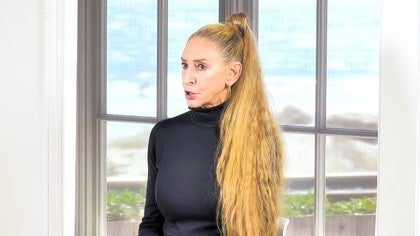
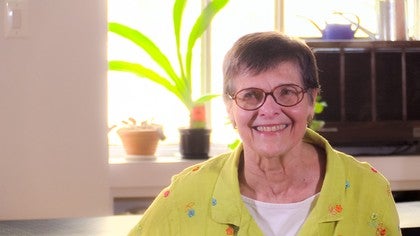
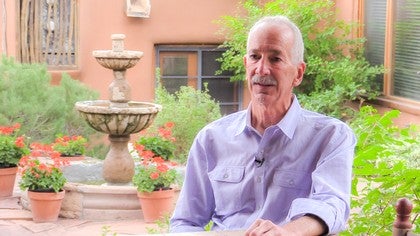














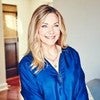


 I cant wait to put this on my favorites list. :) :) :) Please keep us posted. You guys ROCK.
I cant wait to put this on my favorites list. :) :) :) Please keep us posted. You guys ROCK.


